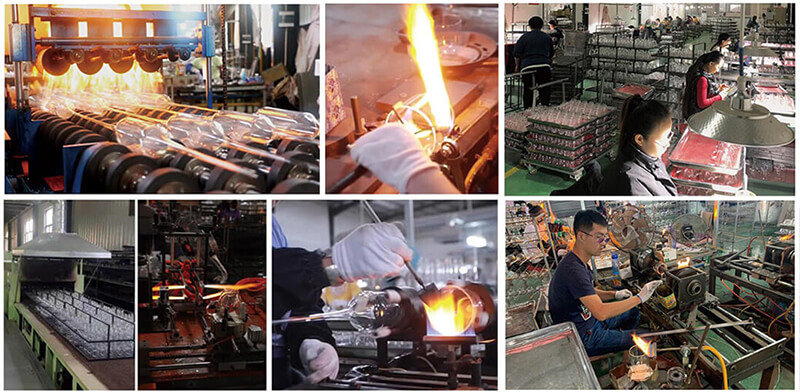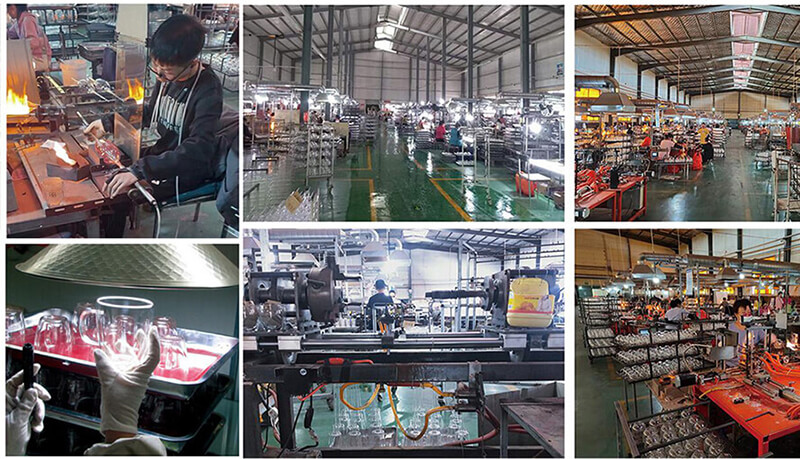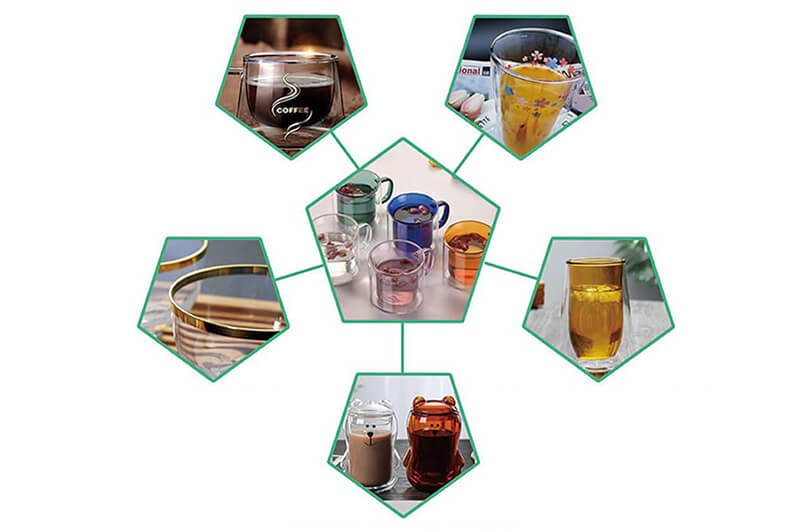The art of glass-making stretches back thousands of years, a testament to human creativity and technological pursuit. Before we dive into the specifics of glass cup manufacturing, it’s essential to understand the foundational elements of glass making. This understanding begins with the raw materials and extends through the magical transformation these materials undergo in the hands of skilled craftsmen and modern machinery.
Raw Materials: The Building Blocks
At the heart of glass making are four primary raw materials: sand (specifically silica), soda ash (sodium carbonate), limestone (calcium carbonate), and cullet (recycled glass). These ingredients are carefully measured and mixed, creating a batch that is ready for the furnace. Silica acts as the backbone, providing structure; soda ash lowers the melting temperature; limestone stabilizes the mixture, and cullet helps the mixture melt more efficiently.
The Glass Melting Process: A Chemical Transformation
Once the batch is prepared, it’s subjected to extreme heat in a furnace, reaching temperatures up to 1700°C (about 3090°F). This intense heat triggers a series of chemical reactions, transforming the solid raw materials into a molten state. The silica molecules, initially rigid and crystalline, begin to loosen and flow, creating a thick, viscous liquid: glass.
Viscosity and Glass Formation
Viscosity, or the measure of a fluid’s resistance to flow, is a critical factor in glass making. As the molten glass cools, its viscosity increases, allowing craftsmen or machines to shape it. This stage is crucial for forming glass cups, as the right viscosity is needed to mold, blow, or press the glass into its desired shape. The skill lies in managing the temperature and timing to ensure the glass is malleable enough to be worked with, yet stable enough to maintain the intended form.
Cooling: The Annealing Process
After shaping, the glass must be cooled slowly in a controlled process known as annealing. This step is vital for relieving internal stresses within the glass, preventing cracking or shattering. The annealing process involves gradually lowering the temperature of the glass in a special oven, ensuring the glass cup’s structural integrity and durability.

Overview of Glass Cup Manufacturing Methods
The transformation of raw glass into the cups we use daily involves a series of intricate processes, each method bringing its own unique qualities and characteristics to the final product. From traditional techniques passed down through generations to modern, automated systems that push the boundaries of precision and efficiency, the manufacturing of glass cups is a study in the balance between art and science.
Hand Blown Glass Cups: The Artisan’s Touch
One of the oldest and most revered methods of glass cup manufacturing is hand blowing. This technique, which dates back to the first century BCE, involves skilled artisans who use a blowpipe to inflate molten glass into a bubble, and then shape it into a cup by hand or with the aid of simple tools. The artisan’s touch in hand-blown glass cups ensures that no two pieces are exactly alike, each bearing the unique marks of its creator’s skill and style. This method is cherished for producing glassware with unmatched beauty and individuality, often featuring vibrant colors and intricate patterns.
Pressed Glass Cups: Efficiency and Uniformity
In contrast to the artisanal approach, pressed glass involves pressing molten glass into a mold using a plunger. Introduced in the 19th century, this method allowed for the mass production of glass cups, making them more accessible to the general public. Pressed glass cups are characterized by their uniformity and durability, with the ability to produce a wide range of designs and textures. This method is particularly suited for creating intricate patterns and detailed reliefs that would be difficult to achieve by hand.
Molded Glass Cups: Precision and Complexity
Molded glass takes the concept of shaping glass in a mold further, allowing for more complex and detailed designs. Unlike pressed glass, molded glass cups can have varying thicknesses and more intricate shapes, thanks to advanced mold-making technologies. This process is highly versatile, accommodating a vast array of cup designs, from simple and sleek to elaborate and ornate. Molded glass manufacturing combines the precision of modern engineering with the creative potential of glass as a medium, offering vast possibilities in glass cup design.
Automated Glass Forming: The Modern Era
The advent of automated glass-forming technologies has revolutionized the glass cup manufacturing process. Machines can now perform tasks that were once solely the domain of skilled artisans, such as blowing, pressing, and molding glass with incredible speed and consistency. This automation has dramatically increased production rates, ensuring that high-quality glass cups can be produced in large quantities to meet global demand. While automation may lack the personal touch of handcrafted methods, it excels in producing standardized, durable glassware efficiently.

Finishing Techniques for Glass Cups
Once the basic shape of a glass cup is formed, it undergoes various finishing techniques that enhance its appearance, durability, and functionality. These techniques, ranging from annealing to decorative finishes, are crucial for ensuring the final product meets the aesthetic and quality standards expected by consumers. Let’s explore these processes that transform a simple glass cup into a work of art or a durable everyday item.
Annealing: Ensuring Durability
The annealing process is the first crucial step after the glass cup has been shaped. This process involves slowly cooling the glass in a controlled environment, known as an annealing lehr, to relieve internal stresses. Without annealing, glass would be prone to cracking and breaking, making this step essential for ensuring the durability and safety of the cup. Properly annealed glass exhibits enhanced strength and resistance to temperature changes and physical impact, making it suitable for regular use.
Surface Treatments: Achieving the Perfect Finish
After annealing, surface treatments can be applied to improve the glass cup’s aesthetic appeal or functional properties. Techniques include:
- Acid Etching: This method creates a frosted appearance on the glass surface, often used for decorative patterns or to provide a non-slip grip.
- Sandblasting: Similar to acid etching, sandblasting offers a way to texture the glass surface, allowing for detailed designs and customization.
- Coating: Special coatings can be applied to glass cups to enhance their durability, resistance to staining, or to add color. These coatings are applied and then cured, bonding them to the glass surface.
Decoration: Personalizing Each Piece
Beyond functional finishes, decorative techniques are employed to give glass cups unique aesthetics, catering to various styles and preferences. Some popular decoration methods include:
- Painting: Hand-painted designs can turn glass cups into collectible items, with artists using special glass paints that are then cured or fired to ensure longevity.
- Decal Application: Decals allow for intricate designs and logos to be transferred onto glass cups, often used for branding or commemorative items. These are applied and then fired in a kiln to fuse them with the glass surface.
- Engraving: Engraving involves cutting or etching designs into the glass, creating a tactile and visual contrast. This method is highly valued for personalized gifts or premium glassware.

Quality Control and Sustainability in Glass Cup Manufacturing
Ensuring the quality and sustainability of glass cups is paramount in today’s environmentally conscious world. Manufacturers employ rigorous quality control measures while also striving to adopt sustainable practices that minimize environmental impact. This dual focus not only ensures the production of high-quality glassware but also addresses the growing consumer demand for eco-friendly products.
Quality Control: The Pillars of Excellence
Quality control in glass cup manufacturing involves a series of inspections and tests designed to ensure that each product meets strict standards for durability, safety, and appearance. This process includes:
- Visual Inspections: Skilled workers or automated systems examine each cup for defects such as cracks, bubbles, or inconsistencies in shape and thickness.
- Performance Testing: Glass cups undergo stress tests, including thermal shock resistance and strength tests, to ensure they can withstand regular use.
- Dimensional Checks: Precision measuring tools verify that each cup meets specified dimensions and tolerances, crucial for product uniformity and customer satisfaction.
These stringent quality control measures are essential for maintaining brand reputation and customer trust, ensuring that only the best products make it to market.
Sustainability: A Commitment to the Environment
Sustainability practices in glass cup manufacturing focus on reducing waste, recycling materials, and conserving energy. Key initiatives include:
- Recycling Glass: Cullet, or recycled glass, plays a significant role in glass production, reducing the need for raw materials and lowering the energy required to melt the glass.
- Energy Efficiency: Modern furnaces and manufacturing processes are designed to minimize energy consumption, with some facilities using renewable energy sources to further reduce their carbon footprint.
- Waste Reduction: Manufacturers strive to minimize waste throughout the production process, recycling scraps and optimizing resource use.
These efforts not only contribute to environmental protection but also enhance operational efficiency and can lead to cost savings.
The Future of Glass Cup Manufacturing
The future of glass cup manufacturing is shaped by continuous innovation and a growing emphasis on sustainability. As we look ahead, several trends and advancements promise to redefine the industry.
Technological Advancements: Shaping Tomorrow
Emerging technologies such as 3D printing and advanced automation are set to offer new possibilities in glass cup design and production. These technologies enable the creation of complex shapes and intricate designs with precision and efficiency, opening up new avenues for customization and creativity.
Sustainability Trends: A Greener Future
The industry is witnessing a shift towards more sustainable manufacturing practices. This includes the development of bioactive glasses with lower melting temperatures, reducing energy consumption, and the exploration of sustainable raw material alternatives that could further decrease the environmental footprint of glass production.



2 Responses
It is excellent idea
I understand this question. It is possible to discuss.